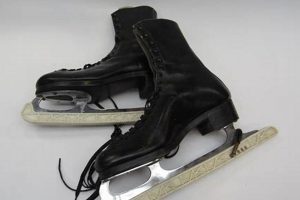These historical objects, typically crafted from wood and featuring a metal blade affixed to the bottom, represent an early form of recreational and practical footwear designed for gliding across ice. Examples range from rudimentary bone or wood attachments to more sophisticated designs incorporating leather straps and forged steel runners.
The significance of these items lies in their reflection of social history, technological development, and the evolution of winter activities. They provide valuable insights into the materials and methods used by past generations, as well as the cultural importance placed on leisure and transportation in colder climates. Their preservation helps maintain a tangible connection to the past.
The following discussion will delve into the construction techniques, historical origins, collectibility, and preservation considerations associated with these artifacts, providing a detailed examination of their unique characteristics and enduring appeal.
Tips for Identifying and Preserving Antique Wooden Ice Skates
The identification and preservation of antique wooden ice skates requires careful attention to detail. This section offers practical guidelines to assist collectors and enthusiasts in maintaining these historical artifacts.
Tip 1: Authentication through Construction: Examine the method of blade attachment. Hand-forged blades secured with hand-pegged construction are typically indicative of older examples, differentiating them from machine-made versions.
Tip 2: Material Identification: Differentiate between wood types. Hardwoods like maple and birch were commonly used for their durability. Identifying the wood can assist in dating and determining the skate’s origin.
Tip 3: Assessing Blade Condition: Evaluate the blade for signs of corrosion or damage. Minor surface rust can be addressed with specialized techniques, but significant pitting or breakage may compromise the skate’s integrity and historical value.
Tip 4: Strap and Binding Analysis: Scrutinize the leather straps and bindings. Original leather will often exhibit wear and discoloration consistent with age. Replacement or altered straps can reduce the skate’s authenticity.
Tip 5: Understanding Regional Variations: Research regional skate designs. Different geographical areas often featured unique skate patterns and construction techniques. Familiarity with these variations aids in accurate identification.
Tip 6: Proper Storage Environment: Store these artifacts in a cool, dry environment with stable humidity. Fluctuations in temperature and humidity can cause the wood to warp or crack.
Tip 7: Avoid Abrasive Cleaning: Refrain from using harsh chemicals or abrasive cleaners. Gentle dusting with a soft brush is the preferred method for removing surface dirt.
Adhering to these guidelines ensures the longevity of these historical objects, preserving their cultural and historical significance for future generations.
The subsequent section will provide information on the market value, collectibility, and resources available for further research on these unique artifacts.
1. Construction Materials
The composition of antique wooden ice skates is inherently defined by the materials employed in their creation, directly influencing their durability, performance, and historical value. The choice of wood, typically hardwoods such as maple, birch, or beech, was paramount due to their capacity to withstand the stresses of repeated use in cold, icy conditions. Inferior wood selection would result in warping, cracking, or premature failure of the skate’s platform, rendering it unusable. The type of metal used for the blade often iron or early forms of steel determined its ability to maintain an edge and resist corrosion. For instance, skates intended for recreational use on frozen ponds might feature simpler, less robust blades compared to those designed for long-distance travel across icy terrain. The quality and type of leather used for the straps and bindings also played a critical role, impacting the skate’s fit and the user’s ability to maintain control.
Variations in materials reflect both technological advancements and regional resource availability. Early skates, often dating back to the 18th and 19th centuries, may exhibit a more rudimentary construction, utilizing locally sourced wood and hand-forged iron blades. Later examples, particularly those produced during the industrial revolution, frequently incorporate mass-produced steel blades and machine-cut wooden platforms, reflecting increased efficiency and standardization. Examining the construction materials, including the presence of specific wood finishes or blade treatments, can provide clues about the skate’s origin, intended purpose, and the socioeconomic context in which it was manufactured. For example, a skate featuring imported hardwoods and high-quality steel might indicate a higher price point and a more affluent owner.
In summary, the construction materials of antique wooden ice skates are not merely passive components but rather active determinants of their functionality, longevity, and historical significance. Understanding the relationship between material selection and performance provides invaluable insight into the technological and cultural landscape of the periods in which these artifacts were produced. The preservation of these skates necessitates a thorough understanding of the materials’ properties and potential vulnerabilities to ensure their long-term survival.
2. Blade Forging
The process of blade forging directly influenced the performance and longevity of antique wooden ice skates. The quality of the forged blade dictated its sharpness, durability, and resistance to corrosion, factors critical for effective ice traversal. Early examples exhibit hand-forged blades, often created by local blacksmiths, where the shaping and hardening of the metal relied heavily on the smith’s skill and experience. The inherent variability in hand forging meant that each blade possessed unique characteristics, reflecting the smith’s technique and the specific properties of the metal used. A poorly forged blade could result in premature dulling, breakage, or uneven gliding, severely limiting the skate’s utility. Conversely, a skillfully forged blade would retain its edge for extended periods and provide a smoother, more efficient skating experience. For example, skates used for long-distance travel necessitated blades that could withstand prolonged use and varying ice conditions, demanding a higher level of forging expertise.
The transition from hand forging to mechanized blade production during the Industrial Revolution brought greater consistency and efficiency but also introduced new considerations. Machine-forged blades allowed for mass production and greater uniformity, but the process often sacrificed the individual attention and customization inherent in hand forging. Furthermore, the materials used in machine-forged blades might differ from those used by blacksmiths, potentially affecting their performance and longevity. Examples of antique wooden ice skates with early machine-forged blades often exhibit a more standardized design, reflecting the shift towards mass production and wider accessibility. The method of blade attachment to the wooden platform, whether through riveting, bolting, or other means, also played a critical role in ensuring the skate’s structural integrity and performance. Improper attachment could lead to blade detachment or instability, rendering the skate unusable.
In conclusion, understanding the blade forging process is essential for appreciating the craftsmanship and functionality of antique wooden ice skates. The forging technique, material quality, and method of attachment directly impacted the skate’s performance, durability, and historical value. Examining the blade can provide valuable insights into the skate’s origin, intended purpose, and the technological context in which it was created. Further research into blade forging techniques, metallurgical analysis, and historical records can enhance our understanding of these artifacts and their significance in the history of winter sports and transportation.
3. Strapping Mechanics
The design and implementation of strapping mechanisms on antique wooden ice skates were critical for ensuring a secure and functional interface between the skate and the wearer’s foot. These systems, often crafted from leather or other durable materials, directly impacted the skater’s control, comfort, and safety. The evolution of strapping mechanics reflects advancements in materials science, manufacturing techniques, and a growing understanding of ergonomic principles.
- Material Durability and Flexibility
The choice of materials, such as tanned leather or woven fabrics, significantly influenced the longevity and adaptability of the strapping system. Leather, while durable, required regular maintenance to prevent cracking and stiffness. Flexible materials allowed for a snug fit around the foot and ankle, enhancing control and minimizing discomfort. Examples include the use of multiple layers of leather for added strength and the incorporation of buckles and eyelets for adjustability. Inadequate material selection could lead to premature wear, slippage, and increased risk of injury.
- Buckle and Fastening Design
The design of buckles, clasps, and other fastening mechanisms determined the ease of use and security of the strapping system. Early skates often featured simple buckle designs that required significant force to tighten, while later models incorporated more sophisticated mechanisms that allowed for finer adjustments and greater holding power. The placement and orientation of buckles were also crucial, as poorly positioned buckles could create pressure points and discomfort. Examples include lever-action buckles for quick release and adjustment and the use of multiple straps to distribute pressure evenly across the foot.
- Ankle Support and Stability
The configuration of straps around the ankle directly influenced the skater’s stability and control. High-ankle designs, incorporating multiple straps, provided increased support and reduced the risk of ankle sprains. Lower-cut designs offered greater freedom of movement but sacrificed stability. Examples include the use of reinforced leather panels to provide additional ankle support and the incorporation of padded linings to enhance comfort. The effectiveness of ankle support varied depending on the skater’s skill level and the intended use of the skates.
- Foot Retention and Comfort
The primary function of the strapping system was to securely retain the foot on the wooden platform while minimizing discomfort and chafing. Properly designed straps conformed to the shape of the foot, distributing pressure evenly and preventing slippage. Examples include the use of contoured footbeds to provide arch support and the incorporation of padding to cushion pressure points. Poorly designed straps could lead to blisters, numbness, and reduced skating performance. Attention to foot retention and comfort was essential for maximizing the user’s experience and preventing injuries.
These facets of strapping mechanics, when considered in the context of antique wooden ice skates, highlight the ingenuity and resourcefulness of early skate designers. The evolution of these systems reflects a constant effort to improve performance, comfort, and safety, ultimately shaping the development of winter sports and recreational activities. Examining the strapping mechanisms on antique skates provides valuable insights into the technological and social history of skating.
4. Historical Period
The historical period during which antique wooden ice skates were manufactured significantly influences their design, construction, and cultural significance. Understanding the specific era in which a skate was created provides valuable context for interpreting its features and assessing its historical value.
- Pre-Industrial Era (pre-1850)
Skates from this period were typically handcrafted by local artisans, often incorporating locally sourced materials. Blades were hand-forged, and designs reflected regional variations. The lack of standardization and the prevalence of rudimentary construction techniques are hallmarks of this era. The skates often served dual purposes, for both recreation and practical transportation.
- Industrial Revolution (1850-1900)
The Industrial Revolution brought mass production techniques to skate manufacturing. Steel blades became more readily available, and wooden platforms were often machine-cut, resulting in greater consistency and affordability. This era saw the rise of specialized skate designs for different purposes, such as figure skating or speed skating. Patent records from this period document numerous innovations in blade attachment and strapping mechanisms.
- Early 20th Century (1900-1950)
Skate designs continued to evolve, incorporating new materials such as lightweight metals and improved leather tanning processes. The rise of organized hockey and figure skating competitions influenced skate design, with manufacturers focusing on performance and comfort. Advertising materials from this era provide insights into the social and cultural significance of skating as a leisure activity.
- Post-War Era (1950 onwards)
The introduction of synthetic materials, such as plastics and nylon, revolutionized skate manufacturing. Wooden platforms were gradually replaced by more durable and lightweight alternatives. This period saw the decline in the production of traditional wooden ice skates as new materials and designs gained prominence.
By examining the historical period in which an antique wooden ice skate was produced, collectors and historians can gain a deeper understanding of its origins, construction techniques, and cultural significance. The evolution of skate design reflects broader technological and social trends, making these artifacts valuable historical documents.
5. Regional Variation
The diversity of antique wooden ice skates is significantly influenced by regional variations in design, materials, and manufacturing techniques. Geographic location dictated the availability of resources, the prevailing climate conditions, and the specific needs of the local skating population, resulting in distinct regional styles.
- Blade Morphology and Attachment
Regional blacksmithing traditions and available metal ores shaped the blade’s curvature, width, and steel composition. In regions with abundant iron ore, blades might be thicker and heavier, designed for durability rather than speed. The method of attachment to the wooden platform also varied. Some areas favored riveting, while others employed more intricate bolting or socketing methods. For example, Scandinavian skates often featured longer, thinner blades designed for navigating frozen lakes, while Dutch skates were characterized by their upturned tips and robust construction suited for canal skating.
- Wood Selection and Shaping
The type of wood used for the platform was dictated by local forest resources. Maple, birch, oak, and other hardwoods were favored for their strength and resistance to moisture. The shaping of the platform also varied regionally, reflecting local skating styles and preferences. In some regions, the platforms were flat and rectangular, while in others, they were contoured to provide better foot support and control. For instance, skates from mountainous regions might feature platforms with angled surfaces to facilitate uphill skating.
- Strapping and Binding Systems
The design of strapping and binding systems reflected local craftsmanship and the availability of leather or other suitable materials. Simple leather straps were common in many regions, while more elaborate systems incorporating buckles, laces, or even metal clasps were found in areas with more advanced manufacturing capabilities. Regional variations in clothing styles also influenced strapping design, with some systems designed to accommodate thick winter boots and others tailored for thinner footwear. Consider skates from coastal regions utilizing waterproofed leather or even woven plant fibers for increased resistance to moisture.
- Ornamentation and Decoration
The level of ornamentation and decoration varied significantly by region, reflecting local cultural traditions and social status. Some skates were plain and functional, while others were elaborately carved, painted, or inlaid with decorative materials. The presence of regional motifs or symbols can provide valuable clues about a skate’s origin and the cultural values of its creators. For example, skates from affluent communities might feature silver or ivory inlays, while those from rural areas might be adorned with folk art carvings.
These regional variations underscore the importance of considering geographic context when studying antique wooden ice skates. The interplay of local resources, manufacturing traditions, and cultural preferences shaped the diversity of these artifacts, making them valuable indicators of regional history and craftsmanship.
6. Preservation Methods
The longevity of antique wooden ice skates is directly dependent upon the application of appropriate preservation methods. The materials comprising these artifacts wood, metal, and leather are susceptible to deterioration from environmental factors and inherent material instability. Without intervention, these factors lead to structural weakening, corrosion, and irreversible damage, diminishing the skate’s historical integrity and artifactual value. For instance, wooden components are prone to warping, cracking, and fungal growth in environments with fluctuating humidity. Metal blades are susceptible to rust and corrosion, particularly when exposed to moisture and salts. Leather straps can become brittle, desiccated, and prone to tearing with age and exposure to light. Proper preservation mitigates these risks.
Practical application of preservation techniques involves environmental control, stabilization, and appropriate cleaning protocols. Maintaining stable temperature and humidity levels minimizes the risk of material degradation. Mechanical cleaning, utilizing soft brushes and specialized solvents, removes surface contaminants without causing damage. Consolidation techniques, involving the application of stabilizing agents, strengthen weakened materials. Storage protocols, such as using acid-free enclosures and archival-quality padding, prevent further deterioration. Real-world examples include museums implementing climate-controlled storage for their collections of historical skates, utilizing conservation-grade waxes to protect wooden surfaces, and employing trained conservators to repair damaged leather components.
Effective preservation of antique wooden ice skates presents ongoing challenges. Balancing the desire to maintain original appearance with the need for stabilization requires careful consideration. The selection of appropriate conservation materials and techniques demands specialized knowledge and expertise. Despite these challenges, proactive implementation of established preservation methods is essential for ensuring that these artifacts endure as tangible reminders of past technological innovation and recreational practices.
Frequently Asked Questions
The following section addresses common inquiries regarding the identification, valuation, and preservation of these historical artifacts. These FAQs aim to provide clarity on key aspects of collecting and caring for antique wooden ice skates.
Question 1: How can the age of antique wooden ice skates be determined?
Age determination involves examining construction techniques, materials used, and any markings or stamps present on the skates. Hand-forged blades and rudimentary construction often indicate older examples, while machine-made components suggest a later period. Patent markings, if present, can provide a precise date of manufacture.
Question 2: What factors influence the value of antique wooden ice skates?
Value is determined by several factors, including age, rarity, condition, historical significance, and provenance. Skates with documented historical connections or unique design features tend to command higher prices. Exceptional condition and complete sets, including original straps, also increase value.
Question 3: How should antique wooden ice skates be stored to prevent damage?
Proper storage requires a stable environment with controlled temperature and humidity. Skates should be stored in acid-free enclosures to prevent deterioration. Direct sunlight and extreme temperature fluctuations should be avoided. Leather components should be conditioned periodically to prevent cracking.
Question 4: Is it advisable to restore antique wooden ice skates?
Restoration should be approached with caution. Inappropriate restoration can diminish the historical value of the skates. Cleaning and stabilization are generally recommended, while complete restoration should only be undertaken by qualified professionals familiar with historical preservation techniques.
Question 5: How can one authenticate antique wooden ice skates?
Authentication involves comparing the skates to documented examples and consulting with experts in the field. Examination of construction details, materials, and markings can help to identify reproductions or fakes. Provenance research, tracing the skate’s ownership history, can also aid in authentication.
Question 6: What resources are available for further research on antique wooden ice skates?
Museums, historical societies, and specialized collectors’ groups offer valuable resources for research. Online databases, auction records, and scholarly publications provide additional information. Consulting with antique appraisers specializing in sporting goods can also provide expert insights.
These FAQs provide a foundation for understanding key aspects of antique wooden ice skates. Further investigation into specific skates or related topics is encouraged for a more comprehensive understanding.
The subsequent section will explore prominent collectors and collections of these historical artifacts, showcasing examples of exceptional preservation and scholarly research.
In Conclusion
This exploration of antique wooden ice skates has illuminated their multifaceted significance. From construction techniques and material selection to historical context and regional variations, these artifacts represent a tangible link to past generations. The preservation of these objects is paramount, safeguarding not only their physical integrity but also the cultural heritage they embody.
The continued study and responsible stewardship of antique wooden ice skates ensures that future generations can appreciate their historical value and gain insights into the evolution of technology, recreation, and human ingenuity. Their enduring presence serves as a reminder of the resourcefulness and craftsmanship of bygone eras, urging a commitment to their preservation for posterity.







